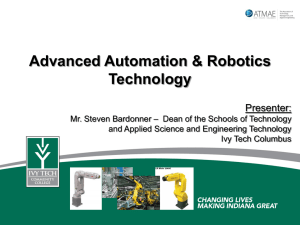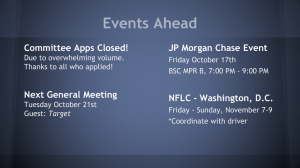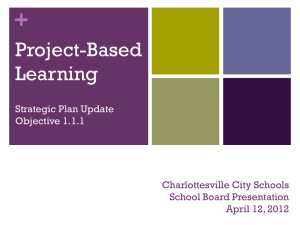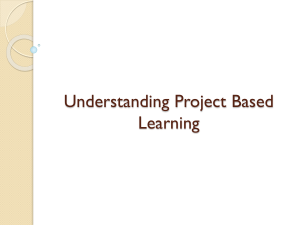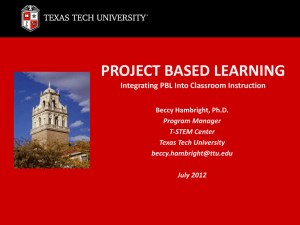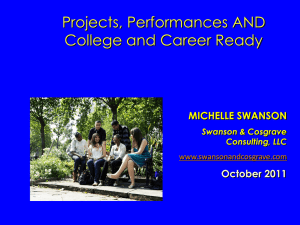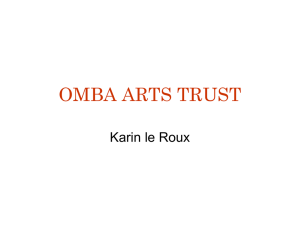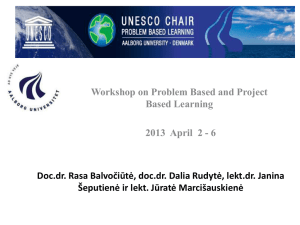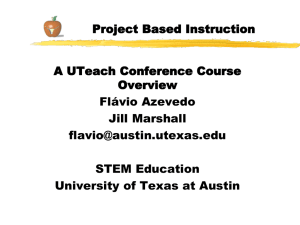Project Based Learning (PBL) - Formative Assessment and
advertisement
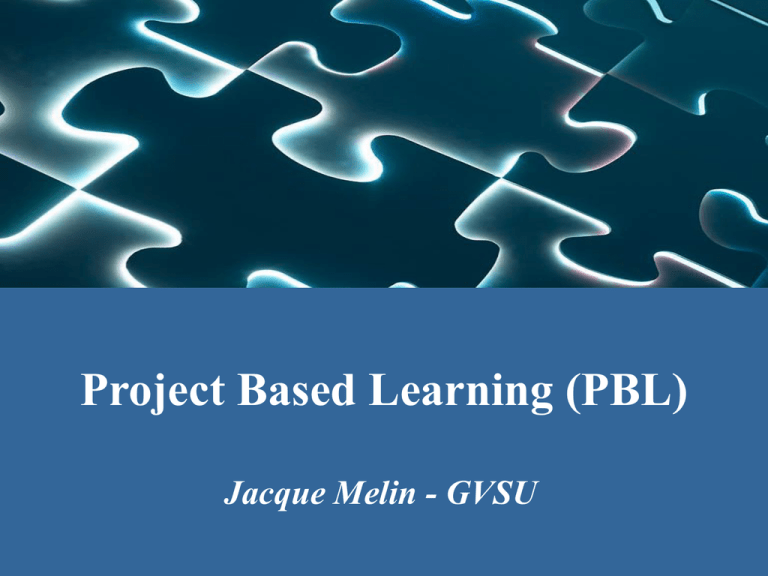
Project Based Learning (PBL) Jacque Melin - GVSU INTRODUCTION TO PROJECT BASED LEARNING (PBL) History of PBL • John Dewey – Benefits of experiential, hands-on, student-directed learning. • Learning Theory Research – social activity – feedback • Standards – clear outcomes – accountability Definition of PBL • A systematic teaching method that engages students in learning knowledge and skills through an extended inquiry process structured around complex, authentic questions and carefully designed products and tasks. Outstanding projects • Recognize students’ inherent drive to learn. Outstanding projects • Engage students in the central concepts and principles of a discipline. Outstanding projects • Highlight provocative issues or questions that lead students to in-depth exploration of authentic and important topics. Outstanding projects • Require the use of essential tools and skills, including technology, self-management, and project management. Outstanding projects • Specify products that solve problems, explain dilemmas, or present information generated through investigation, research, or reasoning. Outstanding projects • Include multiple products that permit frequent and consistent feedback so students can learn from experience. Outstanding projects • Use performance-based assessments that communicate high expectations, present rigorous challenges, and require a range of skills and knowledge. Outstanding projects • Encourage collaboration in some form, either through small groups, studentled presentations, or whole-class evaluations of project results. Can Project Based Learning work in my school? • For students with basic skills issues: – More direct instruction during project – Design shorter projects – Tie projects to fewer and more specific standards BEGIN WITH THE END IN MIND STEPS FOR DEVELOPING A PBL STEPS FIRST STEP – Develop the Project Idea 1. 2. 3. 4. 5. 6. 7. Use your standards. Find projects and ideas on the Web. Map your community. Match what people do in their daily work. Tie the project to local and national events. Focus on community service. Work backward from the topic. • Project Based Learning http://pbl-online.org/ • Edutopia http://www.edutopia.org/ • Buck Institute for Education http://www.bie.org SECOND STEP – Decide on the Scope of the Project Duration Breadth Small Project Ambitious Project 5-10 days Most of semester 1 topic/1 standard Multiple disciplines and Technology Outreach Partnership Limited Classroom based One teacher Extensive Audience Classroom or school Expert panel standards Community based Multiple teachers and community members SECOND STEP – Decide on the Scope of the Project Project Design and Students’ Role Limited Student Input Teacher selects topic Maximum Student Input Teacher solicits student input Students select topic Teacher defines Teacher and Students define learning outcomes student negotiate learning outcomes learning outcomes SECOND STEP – Decide on the Scope of the Project Project Activities and Students’ Role Limited Student Autonomy Teacher defines products and activities Teacher controls timeline and pace of project Maximum Student Autonomy Teacher solicits student input Teacher solicits student input Students define products and activities Students determine timeline and pace of project THIRD STEP – Select Standards Accountability: What do you want your students to KNOW, UNDERSTAND and BE ABLE TO DO? THIRD STEP – Select Standards Accountability: What would you be embarrassed about if your students couldn’t discuss them intelligently at the end of the project? THIRD STEP – Select Standards Accountability: TIP: Try NOT to meet too many standards in a short project – no more than 3 per subject. THIRD STEP – Select Standards Accountability: TIP: Include at least one literacy outcome in your project – assess writing, speaking and/or reading. FOURTH STEP – Incorporate Simultaneous Outcomes PBL is not only a way of learning, it’s also a way of working together to gather and present information: Collaboration Performance Based Products Skills (i.e. SCANS) – See handout Habits of Mind – See handout FIFTH STEP – Work from Project Design Criteria The Project should include the 6 A’s • Authenticity • Academic Rigor • Applied Learning • Active Exploration • Adult Connections • thoughtful Assessment Practices FIFTH STEP – Work from Project Design Criteria Other important criteria: Does the project…. Meet standards? Engage students? Focus on essential understandings? Encourage higher-level thinking? Teach literacy and reinforce basic skills? Allow all students to succeed? Use clear, precise assessments? Require the sensible use of technology? Address authentic issues? FIFTH STEP – Work from Project Design Criteria Projects versus Activity-Based Teaching Strategies FIFTH STEP – Work from Project Design Criteria Example Themes Activity-Based Instruction Project-Based Learning Civil War Battles Take a field trip to Gettysburg. Write a report on the experience. Investigate the question “How could wars be made more humane?” Use Gettysburg as an example of a high-casualty battle, comparing it to other battles. Complete a portfolio, including an essay and a literary response journal, then conclude with a debate. FIFTH STEP – Work from Project Design Criteria Example Themes Activity-Based Instruction Project-Based Learning Sound pollution Listen to different sounds. Make a graph. Identify features of common sounds that are disturbing to the ear. Identify five sound pollution problems in the community. Form a task force to investigate the problems and devise technically feasible solutions for each. FIFTH STEP – Work from Project Design Criteria Example Themes Activity-Based Instruction Project-Based Learning Illnesses Hear a doctor talk about different illnesses and then make group posters about one illness. At Newsome Park Elementary School, in Newport News, Virginia, second graders curious about the number of medicines a classmate takes and her frequent trips to the doctor investigate -with the classmate's permission -- the causes of cystic fibrosis. They invite experts to tell them about the disease, write up their research, use graphs and PowerPoint to tell the story, sell pledges to a cystic fibrosis walk-thon and participate in the event. FIRST STEPS – Work from Project Design Criteria Example Themes Activity-Based Instruction Project-Based Learning Ancient Architecture Make posters depicting the architecture of ancient Egypt. Complete a case study on the pyramids using the question “How were the pyramids built?” to address five controversial issues: source of the design, source of materials, time to completion, method of transportation of materials, and contents of the chambers. FIFTH STEP – Work from Project Design Criteria Example Themes Activity-Based Instruction Project-Based Learning Geometry Observe and measure various school buildings and record data. Design a “School of the Future” with scale drawings and models, taking into account the site and anticipated needs. Present plan to an audience of school officials or community experts. SIXTH STEP – Create the Optimal Learning Environment •Give your project one or more connections beyond the classroom. •Study content and apply it to authentic problems. •Alter your classroom’s look and feel. •Make school work more like real work. SIXTH STEP – Create the Optimal Learning Environment •See the whole before practicing the parts. CRAFT THE DRIVING QUESTION Craft the Driving Question • Guidelines for Driving Questions Must be provocative • Sustain students’ interest – Does music video paint an accurate picture of America? Craft the Driving Question • Guidelines for Driving Questions Are open-ended • No easy answers – Should the United States have used the atomic bomb in World War II? Craft the Driving Question • Guidelines for Driving Questions Go to the heart of a discipline or topic. • Can focus on controversies central to a field and debated by the professionals within them. – How safe is our water? Craft the Driving Question • Guidelines for Driving Questions Are challenging • Encourage students to confront difficult issues and try out unfamiliar behaviors. – When are people justified in revolting against an established government? Craft the Driving Question • Guidelines for Driving Questions Can arise from real-world dilemmas that students find interesting. • How could we build a new community center using only materials that are native to our state? Craft the Driving Question • Guidelines for Driving Questions Are consistent with curricular standards and frameworks. • Lead students to master the agreed upon skills, knowledge, and processes that define a course of study. Avoid the Pitfalls • Beware of Bells and Whistles – Project activities must be designed to help answer the Driving Questions. – Sometimes technological tools obscure the problem solving process. – Technology becomes the focus. Refine the Driving Question Was Trumans’ decision to drop the bomb justified? Can the use of nuclear weapons be justified? Refine the Driving Question Was Trumans’ decision to drop the bomb justified? Can the use of nuclear weapons be justified? •Powerful question. •Forces students to confront the dilemmas of war. •Students will learn about history and also about issues that remain relevant today. •Focuses on a number of decisions about the use of nuclear force. •Students must compare these situations •Develop and justify their own decision criteria. Refine the Driving Question How have robotics and automation How might robotics and automation changed our society in the past century? change our town and its businesses in the next century? Refine the Driving Question How have robotics and automation How might robotics and automation changed our society in the past century? change our town and its businesses in the next century? •Good question. •Prompts students to learn about economics and automation. •Leads students to apply what they have learned. •Better question. •Students will need to learn how society has changed from automation and robotics. •More engaging. Refine the Driving Question What is global warming? Should we be worried about global warming in our town? Refine the Driving Question What is global warming? Should we be worried about global warming in our town? •Good beginning. •Topic is central to both earth science and current events. •Brings the Driving Question home. •Students can anchor their investigation in local geography, climate, and ecosystems. Refine the Driving Question What is good writing? What makes writing worth reading? Refine the Driving Question What is good writing? What makes writing worth reading? •Good beginning. •Brings the Driving •Topic is central to language Question home. arts. •Students can anchor their investigation in the real world. PLAN THE ASSESSMENTS CREATE A BALANCED ASSESSMENT PLAN • Pre-assessments • Formative • Summative WORK BACKWARDS • HOW WILL THE PRODUCTS ALLOW STUDENTS TO DEMONSTRATE LEARNING? – Example: • 2 Academic Content Standards • Oral Presentation and Research Skills • The Habit of Mind of Reflection THE PRODUCTS & ASSESSMENTS • An exhibition such as a video or oral presentation that requires students to demonstrate knowledge of the subject based on the content standards and presentation skills. (rubric and selected response or extended written response assessment) • A research paper on a topic encompassed by the content standards (rubric) • A journal that records their progress during the project. (informal self assessment) PITFALL • Don’t be overconfident about the role that PBL can play: – Many benefits – NOT efficiency for teaching basic skills of decoding, vocabulary, writing and computation. – Example: Math applications can be built in, but fundamentals are best taught through direct instruction. MAP THE PROJECT KEY STEPS 1. ANALYZE THE KNOWLEDGE & SKILLS REQUIRED IN THE PBL Mock Business Plan Knowledge & Skills needed Already have learned Taught before the project 1. Know business plan format. x 2. Interview skills 3. Editing 4. Know Excel Taught during the project x x x 5. Know how to project a budget x 6. Calculating profit & loss x x 7. Calculating interest on loans 2. Decide How to Launch the Project • • • • • A class discussion A field trip A guest lecturer An activity An entry document 3. Gather Resources • Information – Books, People, Internet Sites, etc. • Supplies – Notebooks, Construction Paper, Display Boards, etc. • Technological Tools – Computers, Cameras, Printers, etc. 4. Draw a Storyboard • Sketch out the project in a visual format – – – – – – – – – Timeline and major milestones and assignments Project launch Sequence of activities Preparation of drafts, rehearsals, practices, prototypes, etc. Scaffold Lessons Due dates for drafts or rehearsals, products Exams Homework assignments Reflection or review Week 1 March 3 Start Anne Frank Introduce Driving Question March 5 Form groups Choose topic Week 2 March 7 Research Reading Collect bibliographies March 10 Research Reading Essay Help Week 3 March 17 Develop Storyboards Outline oral presentation March 19 Storyboard approval Develop multimedia March 12 Collect draft of essay Research March 14 Book Groups Debrief Essays Week 4 March 21 Oral presentation practice Multimedia Essay due March 24 Oral presentation practice Final Multimedia March 26 Practice March 28 Final Presentations MANAGE THE PROCESS A LIST OF CRITICAL MANAGEMENT TASKS • Orient students to the goals of the project. • Group students appropriately. • Organize the project – DAILY (setting and enforcing deadlines, collecting artifacts, offering feedback). • Clarify everything. • Monitor and regulate student behavior. • Manage the workflow. • Evaluate. USE CHECKPOINTS AND MILESTONES • • • • • Ask group leaders to give informal briefings on group progress. Assign quick writes to groups or to the entire class. Interview random or selected students. Survey individuals and groups. Schedule weekly reflection sessions for groups and/or the whole class. • Review student or class checklists of completed project steps. • Examine progress logs completed by individual students or groups. • Write your own project journal. • “Sit in” with groups to monitor progress. • Conduct debriefing sessions following activity or product completion.
